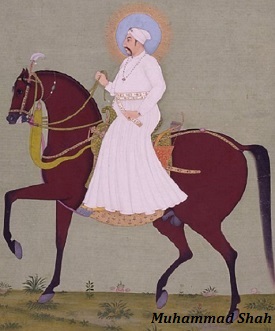Modern Indian History - Muhammad Shah
Muhammad Shah's long reign of nearly 30 years (1719-1748) was the last chance of saving the Empire. But Muhammad Shah was not the man of the moment. He was weak-minded and frivolous and over-fond of a life of ease and luxury.

Muhammad Shah neglected the affairs of state. Instead of giving full support to knowledgeable wazirs such as Nizam-ul-Mulk, he fell under the evil influence of corrupt and worthless flatterers and intrigued against his own ministers. He even shared in the bribes taken by his favorite courtiers.
Disgusted with the fickle-mindedness and suspicious nature of the Emperor and the constant quarrels at the court, Nizum-ul-Mulk, the most powerful noble of the time, decided to follow his own ambition. He had become the wazir in 1722 and had made a vigorous attempt to reform the administration.
Nizum-ul-Mulk decided to leave the Emperor and his Empire to their fate and to strike out on his own. He relinquished his office in October 1724 and marched south to find the state of Hyderabad in the Deccan. "His departure was symbolic of the flight of loyalty and virtue from the Empire.”
After the withdrawal of Nizum-ul-Mulk, many other zamindars, rajas, and nawabs of many states raised the banner of rebellion and independence. For example Bengal, Hyderabad, Avadh, Punjab, and Maratha.



